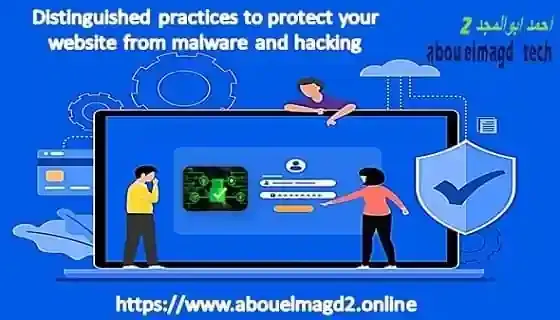With programmers becoming quicker, more varied, and more viable, many organizations are attempting to protect their websites from digital dangers. The statistics don't lie:
- More than 360,000 new malicious files are discovered every day
- In 2017, there were 1,188,728,338 known attacks on computers
- Commercial damages from cybercrime were expected to reach $6 trillion by 2021
- Global spending on cybersecurity is likely to exceed $1 trillion between 2017 and 2021
 |
| Distinguished practices to protect your website from malware and hacking |
These stunning numbers unmistakably delineate why associations should focus on website security. There are different types of cyberattacks and malware. Every IT department must understand the following risks: viruses and worms, Trojans, suspicious packages, malicious tools, adware, malware, ransomware, denial of service, phishing, cross-site scripting (SQL injection), force attack brute password, and session hijacking. When these hacking attempts are successful (and they often are), the following can happen:
While some attacks present only minor threats like a slow website, many attacks lead to serious repercussions like massive theft of confidential data or indefinite website failure due to ransomware. In light of that, the following are 15 accepted procedures your IT division should exploit to protect your association from malware and hacking.
1. Keep your software updated
You must keep your operating system, general applications, anti-malware software, and website security updated with the latest patches and definitions. On the off chance that your website is facilitated by a third gathering, ensure that your host is trustworthy and stays up with the latest too.
2. Cross-site scripting (XSS) attack protection
Hackers can steal login credentials and cookies from users when they sign up or register by inserting malicious JavaScript into your code. Install firewalls and protect against active JavaScript injection in your pages.
3. Protection from SQL attacks
To defend against hackers injecting deceptive code into your site, you should always use parameterized queries and avoid standard Transact SQL.
4. Double data validation
Protect your subscribers by requesting browser and server validation. Double-checking will help prevent malicious scripts from being entered through form fields that accept data.
5. Do not allow files to be uploaded to your website
Some companies require users to upload files or images to their servers. This presents a major security risk as hackers can upload malicious content that puts your website at risk. Remove executable permissions for files and find another way for users to share information and photos.
6. Maintain a strong firewall
Utilize a solid firewall and breaking point outside admittance to ports 80 and 443 as it were.
7. Maintain a separate database server
It is necessary to keep separate servers for all your data and also web servers to further protect your digital assets.
8. Implement the Secure Sockets Layer (SSL) protocol.
Always buy an SSL certificate that will maintain a trusted environment. SSL certificates create a foundation of trust by creating a secure, encrypted connection to your website. This will protect your site from deceitful servers.
9. Create a password policy
Implement strict password policies and make sure you follow them. Teach all clients about the significance of solid passwords. Basically, it requires that all passwords meet these criteria:
10. Use site security tools
Website security tools are essential to Internet security. There are a huge amount of options, both paid and free. In addition to software, there are also Software as a Service (SaaS) models that provide comprehensive security tools for websites.
11. Create a breakthrough response plan
Sometimes security systems are avoided despite the best protection attempts. If this happens, you will need to implement a response plan that includes audit logs, server backups, and contact information for your IT support staff.
12. Set up the backend activity log system
To track the entry point for a malware incident, be sure to track and log relevant data, such as login attempts, page updates, coding changes, and plug-in updates and installations.
13. Maintain a fail-safe backup plan
Your data should be backed up regularly, depending on how often you update it. Ideally, plenty of daily, weekly, and monthly backups are available. Create the appropriate disaster recovery plan for your type and size of business. Make sure to save a copy of your backup locally and off-site (many good cloud solutions are available), allowing you to quickly recover an unmodified copy of your data.
14. Train your employees
It is essential that everyone is trained in the policies and procedures developed by your company in order to keep your website and your data secure and prevent cyber attacks. It only takes one employee to click on a malicious file to have the opportunity to breach. Make sure everyone understands the response plan and has an easily accessible copy of it.
15. Ensure that your partners and vendors are safe
Your business may share and access data with multiple partners and vendors. This is another potential source of the breach. You should guarantee that your accomplices and providers follow web security best practices to assist with protecting your website and your information on the web. This can be done using your own audit process, or you can sign up for software security companies that offer this service.
Even a high-end computer system can quickly collapse due to nefarious malware. Try not to stall in carrying out the above security techniques. Consider investing in cyber insurance to protect your organization should a serious breach ever occur. Securing your website from hacking and cyber-attacks is an important part of keeping your website safe and the security of your business.
For more information on cyber-related risks and cyber liability insurance, visit MMA's Cyber Liability Online Resources https://www.marshmma.com/offerings/business-insurance/cyber-liability.

